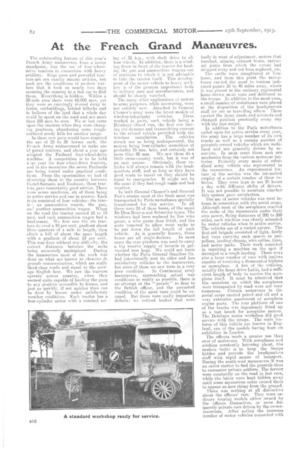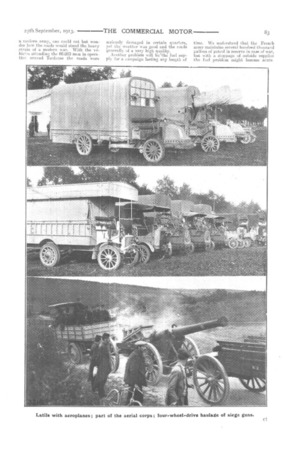At the French Grand Manoeuvres.
Page 10

Page 11

If you've noticed an error in this article please click here to report it so we can fix it.
The outstanding feature of this year's French Army manoeuvres, from a motor standpoint, was the use of four-wheeldrive tractors in connection with heavy artillery. Siege guns and powerful tractors are not exactly minute articles, but such are the conditions of modern warfare thatit took us nearly two days scouring the country in a fast car to find them. Everything is hidden. Within a 20-mile area there were 60,000 men, yet they were so cunningly stowed away in farms, outbuildings, behind hillocks and in hollows of the land that a whole day could be spent on the road and not more than 100 men be seen. We at last came upon the tractors when they were changing positions, abandoning some rough. surfaced sandy hills for another range. As these new guns would have required the use of 25 to 30 horses each, the French Army endeavoured to make use of petrol tractors, and about a year ago adopted the Panhard four-wheel-drive machine. A competition is to beheld ?xt year for four-wheel-drive tractors, anel in the meantime the seven Panhards are being tested under practical conditions. From the oportunities we had of observing them in the country between Castel-Sarrasin and Toulouse, these tractors gave remarkably good serviee. There were seven machines, six of them being in active service and one in reserve. Each tr sin consisted of four vehicles : the tract() a an ammunition wagon, the gun, an,' another ammunition wagon. When on the road the tractor carried 10 to 15 men, and each ammunition wagon had a brakesman. We first saw the six tractors descend a 10 per cent. gradient about three-quarters of a mile in length, then climb a hill of about the saute length with a gradient of about 13 per cent. This was done without any difficulty, the correct distances between the units
being acenrately maintained. During the manoeuvres most of the work was done on what are known as diemins ne grande communication, which are really third-class roads and equal to the average English lane. We saw the tractors operate across country, when they seemed quite capable of hauling the guns to any position accessible to horses, and just as quickly, if not quicker than can be done by horses under satisfactory weather conditions, Each tractor has a four-cylinder motor with a nominal rat-
ing of 32 Ilan, with shaft drive to all four wheels. In addition, there is a winding drum in front of the tractor for hauling the gun and ammunition wagons out of positions to which it is not advisable to take the tractor itself. This develepmein of the motor vehicle to heavy artilkry is of the greatest importance beth to military men and manufacturers, and should be closely watched. •
The many other applications of motors to army purposes, while interesting, were not entirely new. Attached to General Chomer's army wore the latest models of wireless-telegraphy vehicles. These worked in pairs, each vehicle being a Delahaye closed van, the first one having the dynamo and transmitting current to the second vehicle provided with the
wireless installation. The • vehicles struck one as being underpowered, the motors being four-cylinder monoblocs of probably 75 m•rn. bore, and certainly not atom than 80 mm. We saw them do a little cross-cuuntry work, but it was of
an easy nature. Obviously, these vehicles will always remain with the headquarters staff, arid so long as they have good roads to travel on they should be equal to emergencies. It might not be the same if they had rough roads and bad weather.
In both General Chomer's and General Pan's armies most of the fresh meat was transported by Paris motorbuses specially transformed for this service. In all there were 24 of these hoses, of the usual De Dion Bouton and Schneider types. The windows had been replaced by fine wire gauze, awire gauze door fitted, and the seats removed to allow meat racks to be put down the full length of each vehicle. As is generally known, these buses are all single-deckers. . In most cases the rear platform was used to carry a big reserve supply of benzole in galvanized iron kegs. We oould not learn whether the Paris General Omnibus Co. had intentionally sent its older and less satisfactory vehicles to the manosuvres, but some of those we saw were in a very poor condition. In Continental army manoeuvres, approaching actual war conditions as nearly as possible, there is no attempt at the " parade" so dear to the British officer, and the unwashed condition of the meat vans could be excused. But there were really important . defects: we noticed brakes that were badly in want of adjustment., motors that knocked, missing exhaust boxes, universal Joints from which the covers had dropped away and not been replaced, etc.
The cattle were slaughtered at Toulouse, and from this point the motorbuses carried the meat to various indicated points 30 to 40 miles away, where it was placed in the ordinary regimental horse-drawn meat vans and delivered to the troops. In addition to the meat vans, a small number of motorbuses were placed at the disposition of the headquarters staff for use as travelling offices. These carried the Army funds and accounts and changed position practically every day with the etat-major.
In addition to the Paris motorbuses called upon for active service every year, the army has a large number of its own trucks as well as a certain number of privately-owned vehicles which are mobilized and are generally driven by reservists. In most cases these men are mechanics. from the various motorcar factories. Probably every make of subsidized army Vehicle was represented in the manoeuvres. An experimental feature of the service was the intensified employ of a certain number of these vehicles. They were kept in use 24 hours a day with different shifts of drivers. It was not possible to ascertain whether this system gave satisfaction. The use of motor vehicles was most intense in connection with the aerial corps. Although most of the aeroplanes reached the scene of the manceuvres under their own power, flying distances of 200 to 500 miles, each machine was closely attended by motor vehicles when in active service. The vehicles are of a varied nature. The first-aid brigade consisted of light, fairly fast vans carrying such spares as propellers, landing chassis, wire cables, tires, and motor parts. Their work consisted in repairing a machine on the spot if damaged in a rough landing. There were also a large ninnber of vans with trailers capable of receiving a dismounted biplane or monoplane. A few of the vehicles, notably the front-drive Latils, had a sufficient length of body to receive the aeroplane itself. It must be admitted that the occasions on which the aeroplanes were transported by road were not very numerous. Certain motorvans in the aerial corps carried petrol and oil and a very extensive assortment of aeroplane engine parts. The rear platform of ono of the trucks was ingeniously fitted up as a test bench for aeroplane motors. The Delahaye motor workshop did good service with the troops. The main features of this vehicle are known in England, one of the models having been on exhibition in London.
The officers made a greater use than ever of motorcars. With aeroplanes and airships constantly hovering abeut, the modern tactic is to keep the troops hidden and provide the headquarters staff with rapid means of transport.. During the south-west manoeuvres it was an easier matter to find the generals than to encounter private soldiers. The former were constantly on the road in fast cars, while the latter were kept hidden away until some mysterious order caused them to appear as men rising from the ground. There was nothing at all distinctive about the officers' cars. They were .ordinary touring models either owned by the officers themselves, or more frequently private ears driven by the ownerreservists. After noting the immense number of motor vehicles connected with a, modern army, one could not but wonder how the roads would stand the heavy Strain of a modern war. With the yehielss attmding the 60.000 men in operation arov.nd Toulouse the roads were seriously damaged in certain quarters, yet. the weather was good and the roads generally of a very high quality. Another problem will betho fuel supply for a ompaign lasting any length of time. We understand that the French army maintains several hundred thousand gallons of petrol in reserve in case nf war, but with a stoppage of outside supplies the fuel problem might become acute.
























